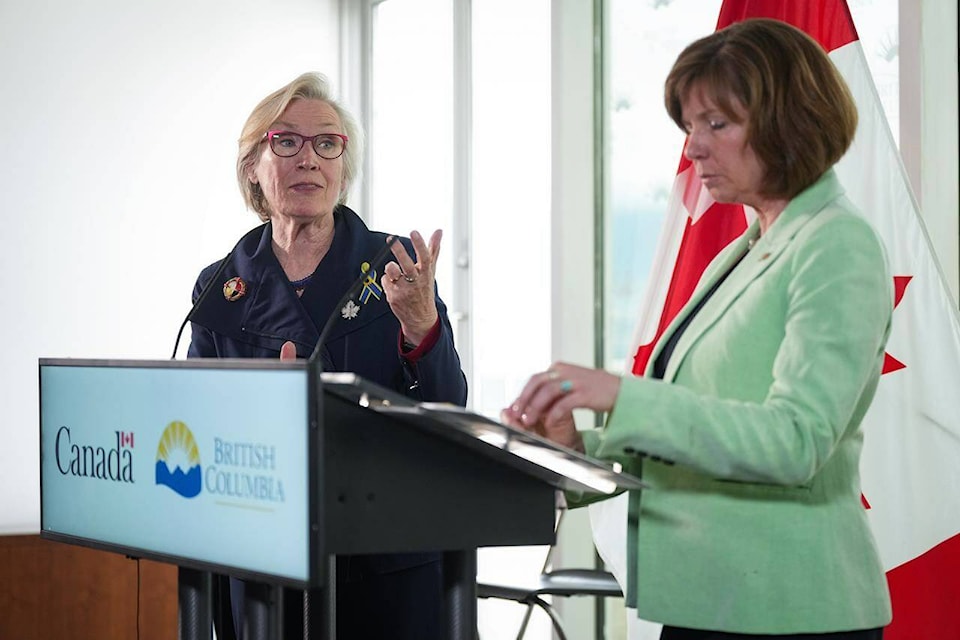B.C.’s mental health and addictions minister is deflecting criticism the amount of illicit drugs being decriminalized is too little by suggesting police will take a more lenient approach to personal possession enforcement.
In an interview with Black Press Media on Thursday (June 2), Minister Sheila Malcolmson described the federal allowance of 2.5 grams as “a floor and not a ceiling.”
Health Canada fell short on approving the requested exemption to of illicit drugs for personal use Tuesday. That decision has been the Canadian Drug Policy Coalition and Vancouver Area Network of Drug Users (VANDU) for being too low of a threshold to make an impact on B.C.’s toxic drug crisis, which has killed over 9,400 people since 2016.
“There is still police discretion and training to be able to recognize when something is trafficking or when it’s personal use, and there should be no seizures even above that threshold level if we do that work well,” Malcolmson said.
But it’s not clear if that is what will occur in practice. The three-year exemption goes into effect Jan. 31, 2023, and states that police will offer information on health supports for people 18 and older found to have up to 2.5 grams of street drugs.
B.C. RCMP spokesperson Sgt. Chris Manseau said in an email it is too early to know how enforcement of the exemption will be handled.
“To imply that there might be a ‘leeway amount’ at this very early stage would be premature. A set amount has been agreed upon, and we will continue to follow that direction, but we are open to adjustments to policies/procedures to align with the guidance from the federal and provincial government.”
Malcolmson said B.C. RCMP and municipal forces have already moved away from possession charges, but are still making seizures. Statistics Canada data shows 1,629 people were charged in B.C. under the Controlled Drugs and Seizures Act in 2020.
In April, members of the ministry’s Decriminalization Core Planning Table wrote a letter to federal Minister of Mental Health and Addictions Carolyn Bennett that called for a non-cumulative approach to possession.
“In order to reduce 75 per cent of drug seizures, which should be a reasonable target given the stated long and short-term policy objectives of decriminalization, threshold levels should be at least over seven grams for opioids, five grams for cocaine, and four grams for amphetamines.”
The letter, which includes signatures from the BC Centre on Substance Use, VANDU and doctors from the University of British Columbia and Simon Fraser University, said there was support for non-cumulative quantities of 4.5 grams, but that Malcolmson had not taken their feedback when deciding on the cumulative total of 4.5 grams.
Malcolmson defended B.C.’s request to the federal government, which included a proposed annual review of the threshold quantity, and said it was informed by the consultation process.
“Our level was based on the evidence that people who struggle … brought to that table, but with a strong commitment from the federal government to monitor and evaluate, and to amend the decriminalization exemption that we’ve received if evidence shows that people are being decriminalized.”
She acknowledged several other shortcomings in the federal exemption.
Harm-reduction experts argue more potent drugs could be introduced into the already dangerous market as a way for users to compensate for the low-possession threshold.
“We’re certainly concerned about the criminalization and about unintended impacts,” said Malcolmson.
The B.C. Corners Service found tested in March contained fentanyl, while 30 per cent contained benzodiazepines, which don’t respond to naloxone treatment. The Canadian Centre on Substance Use and Addiction said in May , a synthetic opioid, in drugs that is more potent than fentanyl.
The limit of 2.5 grams will also be a challenge, she said, for people living in rural communities or remote locations where transportation to supply is a barrier.
“We certainly had both representation and strong concerns from rural users in mind when we built our application. We will be watching very carefully that there are not unintended consequences.”
Users under 18 years old are also left out of the exemption.
Malcolmson said consultation with the ministry’s Decriminalization Core Planning Table did not lead to a call for youth to be included in the new rules. Instead, she said users who aren’t yet adults found to be in possession of illicit drugs will instead be offered alternatives to charges.
She also kept the door open to more being done for youth users.
“We did identify in our application that we think that is important work ahead, but we wanted to take this first fundamental step. We’re going to start with adults, that’s a very clear call we got from people with lived experience, and we’ll learn based on that. Then we’re going to be in a position to amend and expand.”
READ MORE:
•
•
•
•
•
| tyler.harper@nelsonstar.com
Like us on and follow us on .



